Coeburn, VA. | #BluegrassTrails
Part of the mygrassisblue.com #BluegrassTrails series, on the trail of bluegrass history and its pioneers/early protagonists.
A few miles beyond Jimmy Martin’s hometown of Sneedville and it was time to say goodbye to musical Tennessee on this particular road trip. Crossing the rural state line soon had us both back in Virginia and back on the state’s Crooked Road, its Heritage Musical Trail that we spent a few days driving and getting acquainted with last year. It was good to be back in Virginia’s extreme west and southwestern regions. It’s not a particularly large state (the 15th smallest actually) but there’s a very different feel to life over here compared to the historied and busier Eastern Seaboard side of the state. But of course there’s history over here too among the musical mountains of Virginia’s west, bluegrass history.
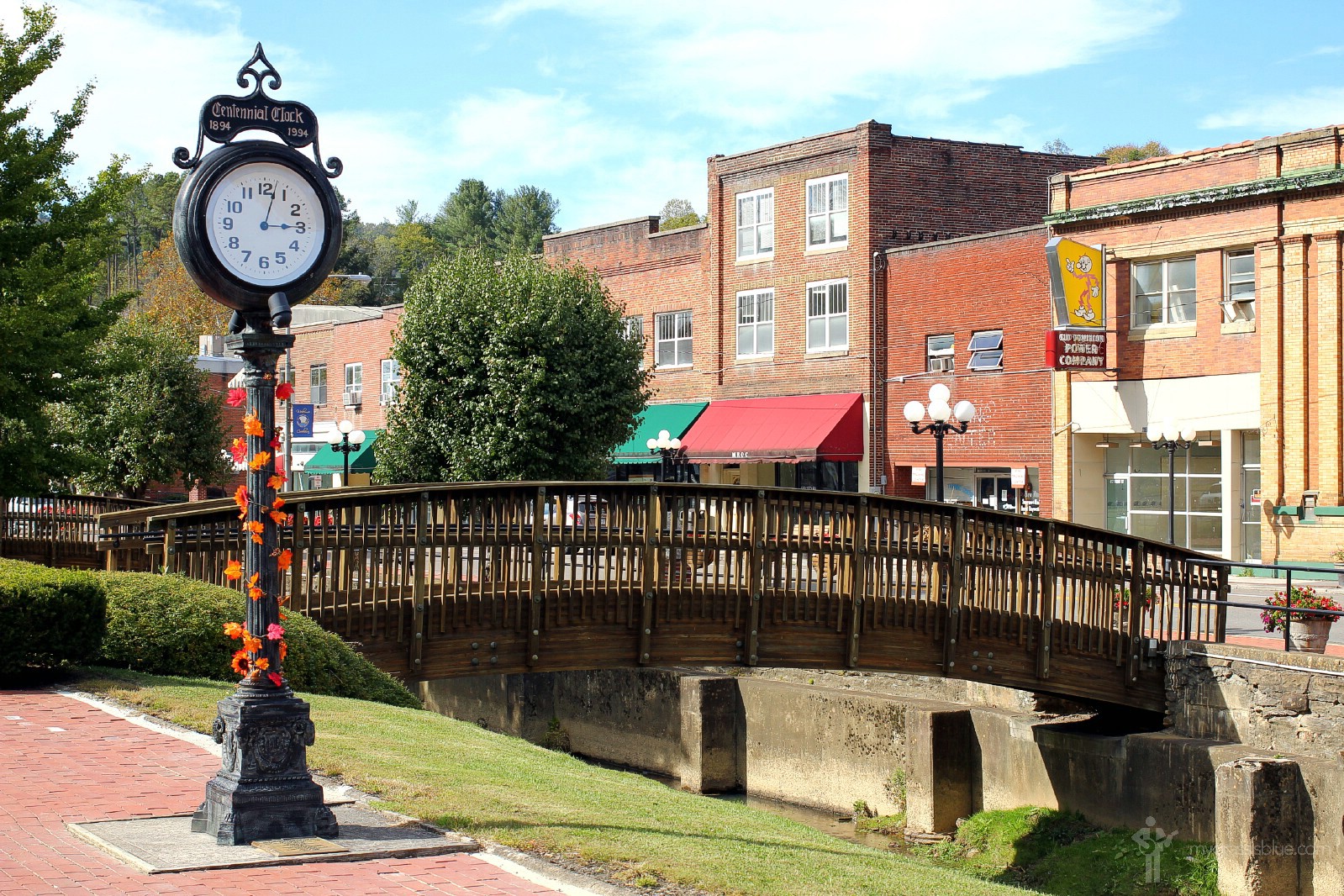
#BluegrassTrails. The Centennial Town Clock outside the old Train Depot in charming Coeburn, Virginia. October 18, 2017.
A town in Virginia’s Wise County along the Guest River some 60 miles from Sneedville, Tennessee, Coeburn was incorporated in 1894. Originally called Guest Station (after explorer and surveyor Christopher Gist), it changed its name to Coeburn in recognition of a W. W. Coe, Chief Engineer of the N&W Railroad, and a judge by the name of W. E. Burns. The town of some 2000-plus inhabitants was quiet when we found ourselves snooping around the old Train Depot off of Front Street on this particular October Wednesday afternoon, a charming redbrick-heavy showcase of antique lamps and clocks, including the freestanding Centennial Town Clock, brick sidewalks, pedestrian bridges over Little Toms Creek, and, this time of year, tasteful fall decoration. Yep, a right little charmer indeed. But we weren’t in Coeburn for the charm. We were here for the town’s association with some rather big-name first-generation bluegrass icons. Four of them.

Coeburn, Virginia. October 18, 2017.
Very few of the sleepy settlements along Virginia’s musical Crooked Road, if any, can top Coeburn’s All-Star lineup of past first-generation bluegrass A-listers. The dual brother duo of Jim & Jesse McReynolds and Ralph & Carter Stanley are already bluegrass royalty, something Ralph Stanley II, the present generation of Clinch Mountain musicians, may attain someday. (Danny O’Quinn Jr.? A still-very-much-alive professional stock car racer.)
The Stanley Brothers
Fiddler Leslie Keith, describing the Stanley Brothers’ band as he joined it in 1947, in Bob Sayers “Leslie Keith: Black Mountain Odyssey,” Bluegrass Unlimited, December, 1976.
Carter Stanley| IBMA Hall of Fame Bio
Carter Stanley interview with Mike Seeger in March of 1966, quoted by Gary Reid in liner notes to The Early Starday/King Years, 1958-1961, Starday/King Records, 2003.
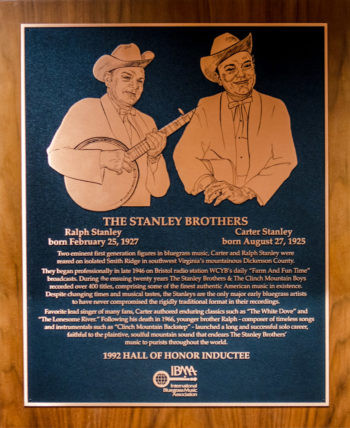
IBMA Hall of Fame Induction | 1992
Born | August 27, 1925 in Big Spraddle Creek, Dickenson County, Virginia
Died | December 1, 1966 in Bristol , Tennessee
Primary Instrument | Guitar
Carter Stanley and his younger brother Ralph grew up in the remote coal and timber fields of southwestern Virginia where they spent most of their lives. Father Lee Stanley was a powerful singer in the Appalachian tradition, which his boys also experienced at the McClure Primitive Baptist Church. Mother Lucy Smith Stanley was accomplished at the clawhammer-style banjo. Both widowed in previous marriages, Lee and Lucy separated when Carter was 16 and Ralph was 14. The boys were close companions and shared a strong interest in the mountain music that surrounded them. They played widely at family and community gatherings, graduating from imagined instruments of kindling wood to the guitar (Carter) and banjo (Ralph) as young teenagers.
After graduating in 1943 from Irvington High School in Nora, Virginia, where he was class president, Carter served two years in the Army Air Corps. Committed to a professional music career, Carter joined Roy Sykes and the Blue Ridge Mountain Boys in 1946, playing daily on WNVA in nearby Norton, Virginia. When Ralph was discharged later that year, Carter and bandmate Pee Wee Lambert left their group to form the Stanley Brothers and the Clinch Mountain Boys. Winning an audition on Bristol’s brand-new 50,000-watt station, WCYB, the group performed daily on the noontime “Farm and Fun Time” for most of the next 12 years. Recordings with Johnson City, Tennessee’s Rich-R-Tone label began in 1947.
The Clinch Mountain Boys at first played in an old-time style reminiscent of Mainer’s Mountaineers. Carter’s songwriting was a distinctive feature of the band’s appeal. “Mother No Longer Awaits Me at Home” and “The Girl Behind the Bar” were followed by “Little Glass of Wine,” which became a regional hit. The influence of Bill Monroe and the Blue Grass Boys and Bill’s alumni Lester Flatt and Earl Scruggs soon had the Clinch Mountain Boys playing a unique fusion of mountain music and the emerging bluegrass style.
Rich-R-Tone Records owner James Stanton, quoted in Rounder Collective, brochure notes to The Rich-R-Tone Story, 1974.
In 1949, the popular act’s signing to Columbia prompted Bill Monroe to leave that label. During the next several years, the Stanley Brothers developed an innovative style of trio singing. Carter sang the verses solo; on choruses Ralph harmonized on a higher tenor line while Pee Wee Lambert sang an even higher baritone part on songs like “The Angels Are Singing,” “The Lonesome River,” and “The White Dove.”
Carter Stanley interview with Mike Seeger in March of 1966, quoted by Gary Reid in liner notes to The Early Starday/King Years, 1958-1961, Starday/King Records, 2003.
A slow period in the winter of 1950-1951 led to a brief hiatus in the Stanley Brothers performances and Columbia recordings. Bill Monroe called upon Carter as a replacement for Jimmy Martin as lead singer with the Blue Grass Boys. The anger Bill had felt toward the Stanleys, whom he felt were copying his music, soon dissipated and the three remained friends for the rest of their lives. In July of 1951, Carter recorded six numbers with Bill, including the notable duet “Sugar Coated Love” and quartets “You’re Drifting Away” and “Get Down on Your Knees and Pray.” By October, the Clinch Mountain Boys were back together and hotter than ever.
In 1953, the band switched labels with Flatt and Scruggs, joining Mercury. This proved a lucky move, as Mercury producer Dee Kilpatrick loved the hard-edge Appalachian sound and stuck with the Stanley Brothers as emergence of rock ‘n roll altered or destroyed the careers of many of their peers. Carter felt the Mercury recordings of the next five years were the brothers’ best. In 1958, the band relocated to Live Oak, Florida, to found the Suwanee River Jamboree on WNER. That year, they joined King Records of Cincinnati, where they remained until Carter’s death.
King’s Syd Nathan encouraged the band to de-emphasize the fiddle, banjo, and mandolin in favor of a two-guitar sound. Nathan also pitched honky-tonk flavored material he felt would more likely appeal to a country music audience. The Stanley Brothers’ only charting single, “How Far To Little Rock,” peaked at number 17 in Billboard in 1960. Ironically, it was the folk music audience that carried the Stanley Brothers to global prominence and appearances in the 1960s.
A brooding personality, a decade of road travel away from home and the mountains he loved, and meager financial rewards for his strenuous musical labors perhaps contributed to Carter’s deepening alcoholism. His health suffered, and bandmates Ralph Stanley and George Shuffler were increasingly required to fill Carter’s roles as emcee and lead singer. Carter appeared at the first multi-day bluegrass festival in Fincastle, Virginia, Labor Day Weekend of 1965, where he triumphantly reprised his recordings with Bill Monroe in the Sunday afternoon “Bluegrass Story.” December 1, 1966, two months after his last concert at Monroe’s Brown County Jamboree in Bean Blossom, Indiana, Carter Stanley died of liver failure. He was 41.
– Reproduced from the Carter Stanley entry on the Hall of Fame Inductees page of the Bluegrass Music Hall of Fame & Museum website
Ralph Stanley| IBMA Hall of Fame Bio
Ralph Stanley interview with Barry Willis in America’s Music: Bluegrass, 1989.

IBMA Hall of Fame Induction | 1992
Born | February 25, 1927 in Big Spraddle Creek, Dickenson County, Virginia
Died | June 23, 2016 in Coeburn, Virginia
Primary Instrument | Banjo
Ralph Stanley and his older brother Carter grew up in the remote coal and timber fields of southwestern Virginia where they spent most of their lives. Father Lee Stanley was a powerful singer in the Appalachian tradition, which his boys also experienced at the McClure Primitive Baptist Church. Mother Lucy Smith Stanley was accomplished at the clawhammer-style banjo. Both widowed in previous marriages, Lee and Lucy separated when Ralph was 14 and Cater was 16. The boys were close companions and shared a strong interest in the mountain music that surrounded them. They played widely at family and community gatherings, graduating from imagined instruments of kindling wood to the guitar (Carter) and banjo (Ralph) as young teenagers.
After graduating from high school in May of 1945 at the age of 18, Ralph Stanley was inducted into the army. He served a year with the occupation forces in Germany. His administrative talents were recognized there and he was urged to reenlist but decided instead to study veterinary medicine. As he arrived home, Ralph was taken by his father directly from the railroad station to a radio broadcast in Norton, Virginia, where he performed with his brother and Roy Sykes and the Virginia Mountain Boys. Carter Stanley and Pee Wee Lambert soon left that band to form the Stanley Brothers and the Clinch Mountain Boys.
The Ralph Stanley Story: An Interview with Fred Bartenstein. Muleskinner News, March, 1972.
Ralph began playing banjo in a two-finger style reminiscent of Wade Mainer. He heard the emerging three-finger style from Snuffy and Hoke Jenkins, and adapted a distinctive variant in 1948, while both the Stanley Brothers and Flatt and Scruggs were appearing on WCYB, Bristol.
Old-Time Man interview by Don Harrison, Virginia Living, June, 2008.
Ten years of regional stardom followed, centered on WCYB radio’s daily “Farm and Fun Time” radio program. The Stanley Brothers were picked up by national labels Columbia, and Mercury, but found themselves unable to break out of performance circuits where bluegrass was most accepted: North and South Carolina, Tennessee, Kentucky, Virginia, and West Virginia; and areas where Appalachians migrated for employment in Ohio, Michigan, Maryland, and Pennsylvania.
1958 brought major changes in the Stanleys’ career. They moved to Live Oak, Florida, and founded the Suwanee River Jamboree, and soon picked up a television and radio circuit for the Jim Walter Homes Corporation. That year they began recording for Starday and King, labels focused on ethnic niches overlooked by mass media. Ralph managed the band’s business affairs and, as Carter’s health began to fail, found himself increasingly fronting the band as lead singer and master of ceremonies.
The Stanley Brothers were discovered by new audiences, not only in the deep south, but in cities, at colleges, and in Europe, as the folk music boom of the early ‘60s spread. In 1965, they drove up from Florida for the first multi-day bluegrass festival in Fincastle, Virginia. Carter’s death in December of 1966 came before the festivals grew into a viable performance circuit.
Ralph faced a true dilemma as he entered his forties. Should he change careers in order to better provide for his growing family? Or should he revamp the Clinch Mountain Boys? King Records’ Syd Nathan and the fans urged the latter course, and soon Ralph was running the roads again, in a station wagon with Curly Ray Cline, Melvin Goins, and a 19-year-old Larry Sparks.
The Ralph Stanley Story: An Interview with Fred Bartenstein. Muleskinner News, March, 1972.
In April of 1968, Ralph moved from Florida back to his childhood home, where he began a Memorial Day bluegrass festival in 1971. In 1970, Ralph and the band (Roy Lee Centers, Curly Ray Cline, and Jack Cooke) were late to a show in West Virginia. As he arrived, he heard 15-year-olds Ricky Skaggs and Keith Whitley filling in with songs of the early Stanley Brothers. Recognizing both their love for his music and amazing talent, Ralph Stanley added the two teenagers to the group for two summers and whenever else they could get away from school.
Ralph Stanley mentored many other fine musicians over the years, including guitarists Ricky Lee, Junior Blankenship, Charlie Sizemore, Sammy Adkins, Tony “Renfro” Profitt, James Alan Shelton, and (son) Ralph Stanley II; mandolinists Ron Thomasson, John Rigsby, and (grandson) Nathan Stanley; fiddlers James Price, Todd Meade, and Dewey Brown; and banjo picker Steve Sparkman.
An endless string of recordings emerged on King, Rebel, Columbia (again) and numerous smaller labels. The Clinch Mountain Boys have headlined for the entire four decades of bluegrass festivals. The movie “O Brother Where Art Thou” (2000) brought Ralph Stanley’s music to the largest audiences of his career, and led to a Grammy award for “Oh Death.” After performing professionally in seven decades, the octogenarian is beginning to slow down a bit. Son Ralph Stanley II heads the Clinch Mountain Boys on a number of their dates. But Ralph, Sr. can still be heard on the Grand Ole Opry and major concert events. His career is well-documented in the Ralph Stanley Museum on the Crooked Road at Clintwood, Virginia, and in a 2009 autobiography coauthored with Eddie Dean.
– The above is reproduced from the Ralph Stanley entry on the Hall of Fame Inductees page of the Bluegrass Music Hall of Fame & Museum website
UPDATE, JUNE 2016: Ralph Stanley died on June 23, 2016.
Quoted in “Ricky Skaggs Reacts to the Death of His ‘Hero’ Ralph Stanley,” countryrebel.com, accessed August 18, 2018
Elsewhere | Video
This now defunct The Nashville Network (TNN) biography on Ralph Stanley, produced as part of the TNN’s ‘The Life And Times Of -‘ series and dated to the mid-1990s, looks at his life from his upbringing in the hills of Virginia’s Dickenson County right through to the influence he has had on contemporary country stars. The documentary includes input from, among others, Marty Stuart, Dwight Yoakam, Ricky Skaggs, Kathy Mattea, Connie Smith, and bluegrass historian Eddie Stubbs (53 minutes 50 seconds).
The Stanley Brothers – with George Shuffler (lead guitar, baritone vocals), Don Miller (fiddle) and Chick Stripling (bass) – playing ‘Worried Man Blues’. The video is undated but was recorded for episode 18 of Rainbow Quest, a 39-episode low-budget Pete Seeger hosted television series devoted to folk music that was recorded between 1965 and 1966, the year Carter died. (2 minutes 51 seconds)
Mid-1966 footage of the Stanley Brothers playing ‘How Mountain Girls Can Love’. (2 minutes 18 seconds)
Mid-1966 footage of the Stanley Brothers playing ‘The Rank Stranger’. (3 minutes 36 seconds)
We do love this video (broadcast date unknown, 41 minutes 07 seconds), even though the portion of interest here is brief (from approx. 3:20 until 15:40). TNN’s Nashville Now in which a Ralph Emery interviews Bill Monroe, who he calls the ‘king of bluegrass’, and Ralph Stanley. Bill performs (from 3:45) and is interviewed first (from 6:10). Ralph Stanley and his Clinch Mountain Boys then perform (introduced by Bill, from 9:50) before he joins Bill on the sofa (from 12:15 until 15:40). Although the interview is brief, Ralph Stanley’s ‘discovery’ of teenage prodigies Keith Whitley and Ricky Skaggs in 1970 gets a mention, as does Ralph and Carter’s past artistic collaborations with Bill Monroe. While the video references Bill and Ralph performing a number together, it’s not, unfortunately, shown in the video.
Undated video of Ralph Stanley performing ‘Can’t You Hear Me Calling’ with Bill Monroe. We like the accompanying comments on this video hinting to its rarity; there is very little video available of Bill Monroe and Ralph Stanley performing together. (3 minutes 48 seconds)
Rare footage of Ralph Stanley & Clinch Mountain Boys (Ralph Stanley, banjo; Roy Lee Centers, guitar; Keith Whitley, guitar; Ricky Skaggs, mandolin; Curly Ray Cline, fiddle; & Jack Cook, bass) in June 1972. Keith Whitley and Ricky Skaggs, 17 and 18 years old at the time respectively, get the spotlight for the old Stanley Brothers number, ‘We’ll Be Sweethearts In Heaven’ (from 11:15), which they cut for their 1971 debut Tribute To The Stanley Brothers. (21 minutes – Part 1 of 3 – click here for Part 2 (21 minutes) and Part 3 (14 minutes))
Elsewhere | Online
Ralph Stanley Museum
The Ralph Stanley Museum and Traditional Mountain Music Center in Clintwood, Virginia, opened in 2004 and aims to provide an ‘interactive musical journey through the career of Dr. Ralph Stanley and the history of traditional mountain music right here where it all started – the beautiful mountains of southwest Virginia’ while continuously preserving and promoting Bluegrass music through workshops, seminars, and conventions.
The Clinch Mountain Echo, ‘A Site dedicated to Ralph & Carter Stanley and the Clinch Mountain Boys Alumni’.

Outside the old Train Depot in Coeburn, Virginia. October 18, 2017.
There was plenty of love in Coeburn; we could feel it. After all, the town does have the motto ‘The Home of Friendly People’.
Jim & Jesse McReynolds
Raised in the small community of Carfax, about 8 miles southeast of Coeburn, Jim and Jesse McReynolds, Jim two years Jesse’s senior, grew up in a family steeped in traditional mountain music (mostly fiddlers), a background that made it natural for them to follow in the footsteps of their grandfather Charlie McReynolds – he was one of the first to record for RCA in Virginia, at the historic Bristol Sessions in 1927. Beginning their professional career in 1947, Jim & Jesse would perform professionally for the next 55 years, until Jim’s death in 2002, making them the longest active professional brother duet in country music history.
“Ranger Doug” Green, music writer, historian, and member of Riders in the Sky, in the liner notes to Jim & Jesse: Bluegrass and More, Bear Family Records, 1993.
Jesse McReynolds | IBMA Hall of Fame Bio
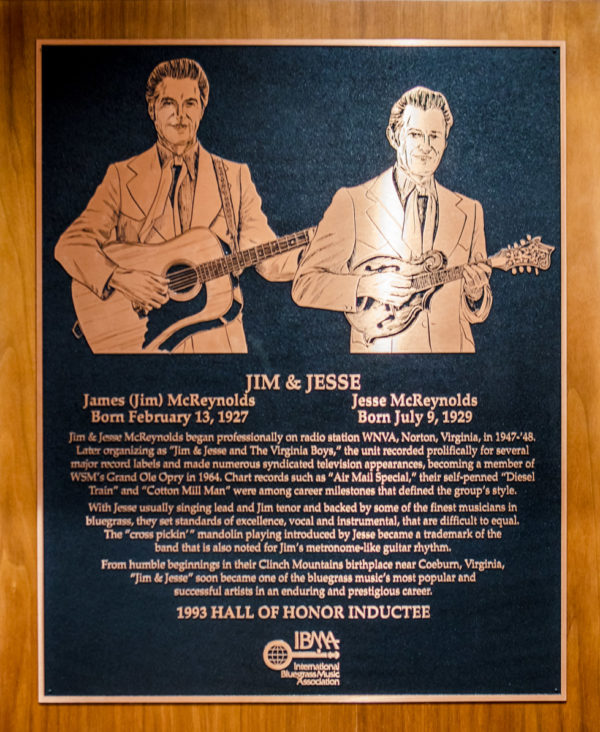
IBMA Hall of Fame Induction | 1993
Born | July 9, 1929 in Carfax, Virginia
Primary Instrument | Mandolin
Soft-spoken and generously warm-hearted, Jesse McReynolds is the younger and lower-voiced of two brothers who were separated as musical partners only by military service and death. Jim and Jesse performed together, composed together, married sisters (Jesse’s first marriage), and lived in adjoining residences – the Double J Ranch in Gallatin, near Nashville, Tennessee. Jesse’s mandolin virtuosity, strong lead vocals, and gentlemanly demeanor have endeared him to millions of fans over seven decades.
– Quoted by Dale Vinicur in liner notes to Jim & Jesse: 1952-1955, Bear Family Records, 1992.
Jesse McReynolds grew up in a mining and farming community among the mountains of southwestern Virginia. Seriously injured in an auto accident at the age of 14, he used the time away from lessons and farm chores to develop his musical skills. A new radio station opened in nearby Norton in 1947 just as Jim mustered out of the Army and Jesse graduated from high school. The brothers formed a group to play a 15-minute daily program, and vowed to pursue a career as entertainers.
With fiddle, mandolin, guitar and bass, the style they played was known as “mountain” or “hillbilly” music. The term “bluegrass” had not yet arisen, but Jesse and Jim McReynolds were impressed and influenced by the new sounds being made by Bill Monroe, Flatt and Scruggs, their neighbors the Stanley Brothers, and early alumni of those bands. Over the next 14 years, the brothers migrated to more than a dozen radio stations in at least 10 states. Whenever they could get a three-finger five-string banjo player, they incorporated that instrument into their band and recordings.
– Quoted in liner notes to Songs from the Homeplace, Pinecastle Records, 1998.
– Quoted by Thomas Goldsmith in liner notes to In the Tradition, Rounder Records, 1987.
In idle moments during 1949, Jesse experimented with using a flat pick to imitate Hoke Jenkins’ backward bluegrass banjo roll on his mandolin. The style quickly evolved into the first full-blown alternative to Bill Monroe’s mandolin technique. Jesse’s “crosspicking,” the brothers’ distinctive smooth vocal duet (influenced by a brief foray into cowboy music), and a propulsive and dynamic band rhythm immediately distinguished the McReynolds’ sound from all others.
– From biography at jimandjesse.com.
A contract with Capitol Records came in 1952, and the group was retitled “Jim & Jesse and the Virginia Boys” (although few of the accompanying musicians who appeared under that name in the next five decades hailed from the Old Dominion). A third and fourth session were squeezed into Jesse’s two-week furlough between Army basic training and departure for the Korean conflict. Jesse drove a jeep in the war zone and played in a five-piece band that also included Charlie Louvin (from the Louvin Brothers, composers of Jim & Jesse’s 1952 release, “Are You Missing Me”).
Starting up again in 1954, Jim & Jesse found a musical landscape greatly changed by rock ‘n roll. They survived by promoting their records directly to establishments with jukeboxes, building new audiences in the rural deep South, pioneering bluegrass music on regional television, and lining up sponsors like Ford Tractors, Pet Milk, and Martha White Mills. A dry spell for recording ended with sessions for Starday in 1958 and 1959, then Columbia and its subsidiary Epic throughout the sixties.
Jesse’s creativity and broad musical awareness led the group in many interesting directions. In addition to a core strength in bluegrass, the brothers experimented with electric country, Latin, pop, gospel, and an entire album of Chuck Berry songs backed by acoustic instruments – “Berry Picking in the Country” (1965). During the folk music boom, the act played the prestigious Newport festival and college campuses. A worldwide audience was built through appearances in the British Isles, Europe, and the Far East. When bluegrass festivals grew to a reliable performance circuit, Jim & Jesse dropped electric instruments and drums and built their own recording label, Old Dominion. In the CD era, they also recorded for CMH, Rounder, and Pinecastle (Jesse’s current affiliation).
Jesse’s son and bass player, Keith McReynolds, contracted multiple sclerosis and died at the age of 44 in 2000. In 2002, both McReynolds brothers were diagnosed with different strains of cancer. Jesse recovered but Jim passed away on the last day of that year. According to Wikipedia, Jesse has carried on the Jim & Jesse tradition and continues to play with the Virginia Boys and Girls. He has recently opened a music park on his family farm in Gallatin, Tennessee, called “The Pick Inn” where he hosts many special events. Jesse’s present band lineup includes grandson Garrett McReynolds as tenor singer/rhythm guitarist. Garrett’s older sister Amanda sings third-part harmony. Sometimes Jesse grabs the historic fiddle his grandfather played on the Bristol Sessions, and lets grandson Luke McKnight do the crosspicking that Jesse invented and made famous. With his musical family Jesse McReynolds continues on, entertaining fans all over the world.
– Reproduced from the Jesse McReynolds entry on the Hall of Fame Inductees page of the Bluegrass Music Hall of Fame & Museum website
Jim McReynolds | IBMA Hall of Fame Bio
Eddie Stubbs’ eulogy, Bluegrass Unlimited, February, 2003.

IBMA Hall of Fame Induction | 1993
Born | February 13, 1927 in Carfax, Virginia
Died | December 31, 2002 in Gallatin, Tennessee
Primary Instrument | Guitar
Jim McReynolds was the elder of two brothers who were separated as musical partners only by military service and death. Jim and Jesse performed together, composed together, married sisters, and lived in adjoining residences – the Double J Ranch in Gallatin, near Nashville, Tennessee.
So much has been made of the duet that Jim’s remarkable voice seldom received the praise it deserved. A tenor with effortless range, Jim sang high harmonies and the occasional lead vocal with gossamer beauty, far from the strident intensity of most rural singers from the southwestern Virginia and eastern Kentucky coalfields.
Remembered as a neatly dressed, quite-spoken, and polite gentleman, Jim McReynolds seldom drew attention to himself. He managed the business of the band, while Jesse was the more visible public spokesman, predominant lead singer, and featured instrumentalist. Jim’s personality showed its strength when the group was treated in a less than dignified fashion or when he bickered with Jesse – as brothers will – about some insignificant matter.
The family was musical on both sides, but eked a living from farming coal mining, and during the Great Depression, the WPA. As a teenager, Jim followed his father into the mines but never returned after the senior McReynolds was almost killed in a mining accident. Jim learned guitar and gospel music from his mother. As World War II ended, he spent a two-year hitch in the Army. He returned home with a mandolin and soon joined his younger brother and his sister’s husband in a local dance and radio band.
Like all regional acts of the era, The McReynolds Brothers and the Cumberland Mountain Boys moved from city to city, angling for higher-wattage stations and playing out the local territory. When the mines were busy, they found their most lucrative bookings in coal country. During an economic lull there, they accompanied Curly Seckler to Augusta, Georgia, for a short hitch with Hoke Jenkins and his Smoky Mountaineers. A year later, the two brothers tried something uncharacteristic of Appalachian bluegrass musicians – they moved to Iowa and Kansas as singing radio cowboys.
Quoted in Julie Knight, “Hoke Jenkins, Pioneer Banjo Man,” Bluegrass Unlimited, September, 1985.
The McReynolds’ first television and recording work came in 1951 and 1952 in southwestern Ohio – Middletown, Dayton, and Cincinnati. Ten gospel songs were cut for the Kentucky label as the Virginia Trio. It was in Cincinnati that they auditioned unsuccessfully for King. Then, in one of those unexpected quirks of fate, they ran into Capitol Records’ Ken Nelson at the Jimmie Skinner Music Center, played a few songs for him, and were invited to record in Nashville. Nelson suggested a new name for the act: Jim and Jesse and the Virginia Boys.
Capitol sessions in 1952, 1953, and 1955 resulted in twenty tracks, sixteen of which were released as 78 and 45 rpm singles. The most enduring were the Louvin Brothers’-penned “Are You Missing Me,” and the McReynolds’ own “I Will Be Waiting for You” and “Just Wondering Why.” The brothers were working at WCYB in Bristol when Jesse was drafted for service in Korea. Jim farmed from 1953 to 1954. Jesse returned to a changed musical landscape; Elvis had hit and even the most prominent bluegrass acts had trouble keeping a major label contract.
In the late fifties and early sixties, Jim and Jesse established their base of broadcasting and touring operations in Danville, Virginia; Burlington, North Carolina; Wheeling, West Virginia; Knoxville, Tennessee, and Live Oak, Florida. In the Deep South, they worked a circuit of television shows for Ford Tractors and Martha White Mills. Jim and Jesse built a tight and powerful performing ensemble with fiddlers such as Vassar Clements, Jimmy Buchanan, and Jim Brock; banjoists Bobby Thompson and Allen Shelton; and utility men Don McHan, Chick Stripling, and David Sutherland. In 1958 and 1959, Jim and Jesse self-produced three sessions in Jacksonville, Florida for the Starday Records, including “Hard Hearted,” “Border Ride,” and “I’m Changing the Words to MY Love Song.”
In 1960, when the folk boom was attracting urban and college audiences for bluegrass acts, Don Law signed the brothers to Columbia Records. On that label and its subsidiary Epic, Jim and Jesse achieved their first top-100 country chart hits: “Cotton Mill Man” (1964), “Better Times a-Coming” (1964), “Diesel on My Tail” (1967), “Ballad of Thunder Road” (1967), “Greenwich Village Folk Song Salesman” (1968), “Yonder Comes a Freight Train” (1968), and “The Golden Rocket” (1970).
Quoted in Robert K. Oermann, “Jim & Jesse: Testing the Boundaries of Bluegrass Music – With a little Help from Charlie Louvin,” Bluegrass Unlimited, September, 1982.
In 1964, Jim and Jesse became members of WSM’s Grand Ole Opry and moved to Nashville. With folk audiences shrinking and the bluegrass festival circuit still on the horizon, the act experienced strong economic pressures to record and perform with electric instruments and drums in a mainstream country format. Nine years later, in 1973, they formed their own record label, Old Dominion, and returned almost entirely to bluegrass for the remainder of their career.
Successful international tours, Opry appearances, and a steady stream of headline appearances at bluegrass festivals allowed Jim and Jesse to continue as full-time musicians through the eighties and nineties. Jim encountered voice problems at the dawn of the new millennium and was diagnosed with cancer in early 2002. Despite surgeries and chemotherapy, he continued to perform whenever he was able. On December 19, 2002, Jim’s wife Arreta died of a massive heart attack. Jim entered hospice care on December 20 and died December 31. He was buried on a mountain overlooking his childhood home in Carfax, Virginia.
– Reproduced from the Jesse McReynolds entry on the Hall of Fame Inductees page of the Bluegrass Music Hall of Fame & Museum website
Elsewhere | Video
In 2014, Jim & Jesse celebrated half a century of Opry membership. It was the success of their 60s radio shows that prompted Martha White Flour to bring them to Nashville to star on their early morning show on WSM, this leading, in 1964, to them to realising their dream of becoming regular members of the Grand Ole Opry.
Radio Shows, originally released in 1978 as a two record set on the Old Dominion label, was recorded in 1962. It contained mainly songs never before recorded by Jim & Jesse and The Virginia Boys, songs selected because of their oft-requested status on their radio shows. Joe Taylor, Jim & Jesse’s former booking agent, stated in the album liner notes, “I hope you enjoy this album, it is down to earth, American music, at its very finest.”
In this video, highlighting the 2017 release of a 24-song disc remastered from the original Radio Shows master tapes, Jesse McReynolds, speaking in early 2014, reflects on the Jim & Jesse radio days, their early Opry membership, and their pending 50th anniversary of Opry membership. (15 minutes 33 seconds)
50 years is good, but 55 is even better! An early 2019 ‘Opry Milestones’ video from the folks at the Grand Ole Opry commemorating the 55th anniversary, on Match 2nd of 2019, of Jesse McReynolds being an Opry Member. Jesse gives glimpses into his time as an Opry Member over the last 55 years. (3 minutes 44 seconds)
A sit-down interview with Jesse McReynolds conducted by Dave Kline, bandleader of Pennsylvania-based bluegrass band Mountain Folk. (24 minutes 35 seconds)
Elsewhere | Podcast
Toy Heart | May 14, 2020
In this awesome podcast from May 2020, Toy Heart host Tom Power sits down and chats candidly with Jessie McReynolds about his extraordinary life in music, from his early years right through to the present today. Well worth an hour-plus of your time. (1 hour 6 minutes)
Elsewhere | Online
JimandJesse.com
JimandJesse.com, the official Jim & Jesse website, is exactly what you’d expect, a site dedicated to all things Jim & Jesse – history, bios, accolades, merch and so much more. It’s Jim & Jesse heaven.
A 2011 Mandolin Cafe interview with Jesse McReynolds with user questions and a whole lot more.
From June 2017, a Bluegrass Today interview with Jesse McReynolds.


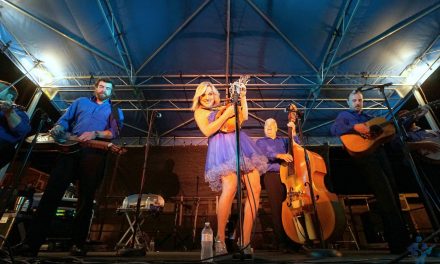
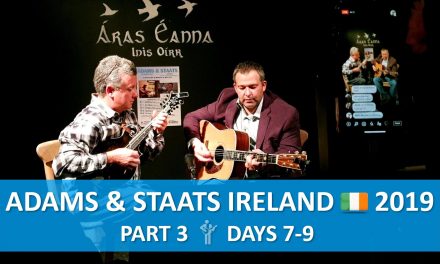
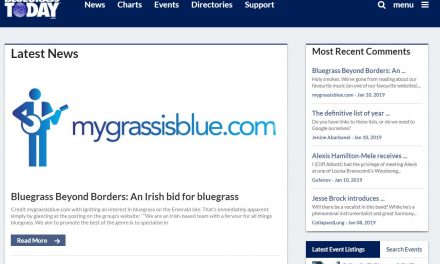
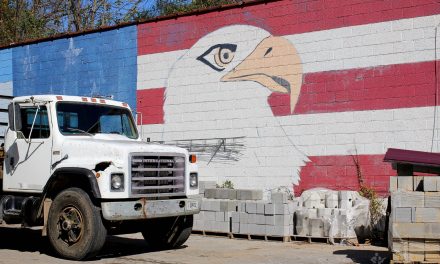

0 Comments